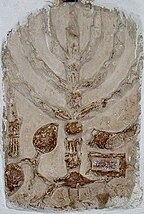Pek'in
| Pek'in | ||
|---|---|---|

|
||
| Basic data | ||
| hebrew : | פְּקִיעִין | |
| arabic : | البقيعة | |
| State : |
|
|
| District : | North | |
| Coordinates : | 32 ° 58 ' N , 35 ° 20' E | |
| Height : | 615 m | |
| Area : | 3.565 km² | |
| Residents : | 5815 (as of 2018) | |
| Population density : | 1,631 inhabitants per km² | |
| Community code : | 0536 | |
| Time zone : | UTC + 2 | |
|
|
||
Pek'in ( Hebrew פְּקִיעִין Pəqīʿīn ; Arabic البقيعة, DMG al-Buqīʿa ) is an Israeli-Druze city in northern Israel .
geography
Pek'in is located eight kilometers east of Maʿalot-Tarshikha in Galilee . 5,815 people live there (as of 2018).
history
The place Pek'in goes back to the historical Baca , which Flavius Josephus called in his work Jewish War . According to Flavius Josephus, the place was on the border between the kingdom of Herod Agrippa II and the kingdom of Tire .
synagogue
The synagogue was built on the site of a historic Beth Midrash , where Rabbi Yehoshua ben Hananiah taught in the period before the Bar Kochba War . In the time after the Bar Kochba War, Rabbi Shimon ben Jochai is said to have taught here. The current building dates from 1873. A Jew named Rafael Halevy from Beirut financed the construction. In 1926 and 1930 two old stone tablets were uncovered in the synagogue. One shows a menorah , shofar and lulav and the second shows a torah shrine . Both are dated between the late 2nd century and the beginning of the 3rd century.
In 1922, Jizchak Ben Zwi visited the Jewish community of Pek'in and documented his visit in his book Shaar Jaschuv . In 1955, Zwi ordered the Israeli Ministry of Religious Affairs to restore the old synagogue. Zwi also had a 100 shekel banknote printed showing the synagogue of Pek'in on the reverse. The currently unused synagogue is maintained by Margalit Zinati. Zinati's family has lived in Pek'in for centuries, since the Second Temple period.
- reception
Individual evidence
- ↑ אוכלוסייה ביישובים 2018 (population of the settlements 2018). (XLSX; 0.13 MB) Israel Central Bureau of Statistics , August 25, 2019, accessed May 11, 2020 .
- ↑ אוכלוסייה ביישובים 2018 (population of the settlements 2018). (XLSX; 0.13 MB) Israel Central Bureau of Statistics , August 25, 2019, accessed May 11, 2020 .
- ↑ Edna J. Stern, Nimrod Getzov, עדנה שטרן, נמרוד גצוב: מנהגי הקבורה הפיניקיים בתקופה הרומית לאור החפירות ליד אל-כברי (Period in ליד אל-כברי / Aspial of Phoenician) . In: 'Atiqot / עתיקות . 51, January 1, 2006, ISSN 0792-8424 , p. 120. Retrieved September 21, 2014.
- ↑ Jürgen Zangenberg , Harold W. Attridge, Dale B. Martin: Religion, Ethnicity, and Identity in Ancient Galilee: A Region in Transition . Mohr Siebeck, 2007, ISBN 978-3-16-149044-6 , pp. 130-131 .
- ^ Steve Mason: Life of Josephus (= Flavius Josephus: Translation and Commentary . Volume 9 ). BRILL, 2001, ISBN 90-04-11793-8 , pp. 179 .
- ^ Marilyn Joyce Segal Chiat: Handbook of Synagogue Architecture . In: Brown Judaic Studies . tape 29 . Scholars Press, 1982, ISBN 978-0-89130-524-8 , pp. 53-54 ( Google Books ).
- ↑ Eli Ashkenaz: Researchers race to document vanishing Jewish heritage of Galilee Druze village In: Haaretz of July 25, 2012.


